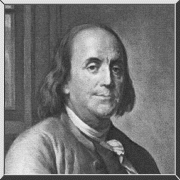 Benjamin
Franklin American statesman, printer, scientist, and
writer, was born in Boston on Jan. 17. He went to Philadelphia in
1723 as a printer and won attention for his wit and common sense
philosophy, especially as expressed in Poor Richard's Almanac which
he published from 1732·57. He helped establish (1751) an academy
that became the present University of Pennsylvania, and he served as
deputy postmaster general of the colonies (1753·74). He helped
draft the Declaration of Independence, which he signed.
Benjamin
Franklin American statesman, printer, scientist, and
writer, was born in Boston on Jan. 17. He went to Philadelphia in
1723 as a printer and won attention for his wit and common sense
philosophy, especially as expressed in Poor Richard's Almanac which
he published from 1732·57. He helped establish (1751) an academy
that became the present University of Pennsylvania, and he served as
deputy postmaster general of the colonies (1753·74). He helped
draft the Declaration of Independence, which he signed.
He began his career as a scientist when in 1740 he invented the Pennsylvania fireplace, later called the Franklin stove, which soon heated buildings all over America. He first tried experiments with electricity in France in 1752 that showed lightening was in fact a form of electricity. His famous experiment with a kite in a thunderstorm proved the presence of electricity in lightning. When the Royal Society in London published these discoveries, and lightening he invented appeared on buildings all over America and Europe. Franklin became world famous. He was elected to the Royal Society in 1772.
His later achievements included formulating a theory of heat absorption, measuring the Gulf Stream, designing ships, tracking storm paths and inventing bifocal lenses. He wrote his memoirs in 1789 and sent copies to England and France. He died before they could be published in April of 1790. Page created by: Dallas Hallam
Books:
Academic American Encyclopedia, 1985.
Franklin, Benjamin; Danbury, Connecticut; Grolier Incorporated.
Benjamin Franklin, 1789, 1951, The Autobiography Of Benjamin Franklin; Heritage Press.
CD-ROM's:
Grolier's Multimedia Encyclopedia, 1996, Franklin, Benjamin;
Grolier Incorporated. Student Reference Library,1996, Franklin, Benjamin; Mindscape, Inc.
Web Sites:
Benjamin Franklin Autobiography http://www.teachersoft.com/Library/nonfict/biog/franklin/contents.htm
Benjamin Franklin, A Great American Scientist. http://www.wpi.edu/~wolfus/ph1121.html
Benjamin Franklin, A Documentary History, J. A. Leo Lemay. http://www.english.udel.edu/lemay/franklin/
Benjamin Franklin, Glimpse of the Man. http://sln.fi.edu/franklin/